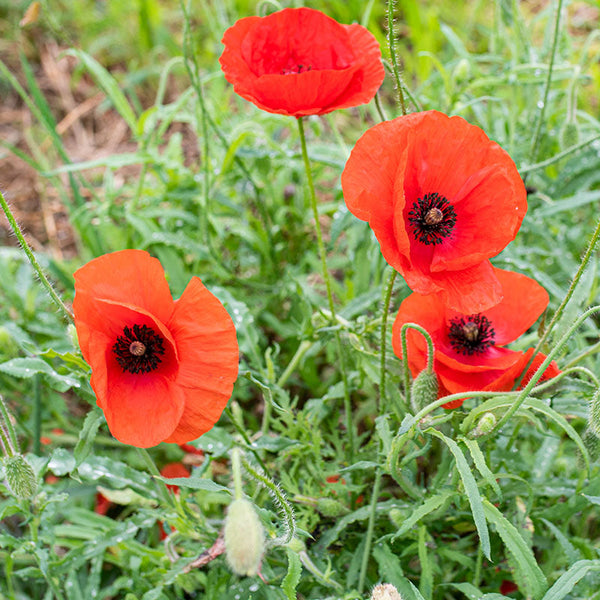Poppies have long captured human imagination. With their delicate, papery petals and striking colors, they bloom like nature’s confetti—bright, fleeting, and unforgettable. Whether dancing in wildflower meadows or cultivated borders, poppies offer a vibrant presence that feels both untamed and poetic.
More than just beautiful, poppies carry centuries of meaning: from remembrance and sleep to peace and resilience. But behind the symbolism lies a surprisingly hardy and easy-to-grow plant that thrives in sunny gardens with minimal fuss.

Portrait of the Poppy
Poppies belong to the Papaveraceae family and include many beloved species such as Papaver rhoeas (common poppy), Papaver somniferum (opium poppy), and Papaver orientale (oriental poppy). Their brilliant flowers and feathery foliage make them garden standouts and pollinator favorites.
- Type: Annual, biennial, or perennial (depends on species)
- Family: Papaveraceae
- Common Names: Poppy, corn poppy, oriental poppy, Iceland poppy
Foliage and Form
Poppies vary widely in height and habit, but most share finely divided or lobed leaves that form a low, bushy mound. Their upright, slender stems hold blooms like floating crepe-paper cups in the breeze.
- Height: 30 cm to 1.2 m (1–4 ft)
- Spread: 20–60 cm (8–24 in)
- Growth Habit: Erect, with airy, delicate form
Blooms and Fragrance
Poppy flowers are their true glory. Each bloom lasts just a few days, but they come in succession, producing a long-lasting display. Most have four to six tissue-thin petals in brilliant reds, oranges, pinks, whites, or purples. Some have dark central blotches; others have frilly or ruffled forms.
- Bloom Time: Spring to early summer (annual types); early summer for perennials
- Color: Red, pink, orange, white, purple
- Fragrance: Minimal or none
📅 The Right Time to Plant, Prune, and Enjoy Poppies
| Month | Planting | Flowering | Pruning |
|---|---|---|---|
| January | ❌ | ❌ | ✅ Cut back old stems (perennials) |
| February | ✅ Start indoors (cool zones) | ❌ | ✅ Clean foliage |
| March | ✅ Direct sow outdoors | ❌ | ✅ Thin seedlings |
| April | ✅ Direct sow or transplant | ✅ (early types) | ❌ |
| May | ✅ (last chance for sowing) | ✅ Peak bloom | ✅ Deadhead spent blooms |
| June | ❌ | ✅ | ✅ Light pruning if needed |
| July | ❌ | ✅ (late bloomers) | ✅ Cut back annuals |
| August | ❌ | ✅ (fall-flowering types) | ✅ Trim dead foliage |
| September | ✅ Fall sowing (mild zones) | ❌ | ✅ Divide clumps (perennials) |
| October | ✅ Direct sow (mild regions) | ❌ | ❌ |
| November | ✅ Sow outdoors (cold stratification) | ❌ | ✅ Clean up beds |
| December | ❌ | ❌ | ✅ Prune back perennials |
✅ = Recommended ❌ = Not advised
Watering, Sunlight, and Environment for Poppies
Watering
Poppies are drought-tolerant once established, especially annual species. Overwatering can cause rot or leggy growth.
- When to Water: Lightly when young; deep water in long dry spells
- How Much: Let soil dry out between waterings
- Watch out for: Root rot in soggy soils
Sunlight
Poppies crave the sun. For lush blooms and strong stems, full sun exposure is non-negotiable.
- Ideal Exposure: 6+ hours of direct sunlight daily
- Shady Sites: Results in spindly growth and poor blooming
Indoor vs Outdoor
Poppies belong outdoors. While some gardeners start seeds indoors, most poppies resent transplanting and do best when direct sown.
- Best Location: Open garden beds, meadows, borders
- Avoid: Long-term indoor growing or cramped containers
Temperature
Poppies grow well in cool to temperate climates and tolerate light frost. Heat can shorten bloom time, but early sowing ensures a strong show.
- Optimal Range: 10–24°C (50–75°F)
- Hardiness Zones: Varies by species:
- Oriental poppy: Zones 3–7
- Iceland poppy: Zones 2–7
- Annual poppies: Re-sown yearly
- Protection Tip: Provide wind shelter for tall varieties
Ideal Soil Conditions for Growing Poppies
| Soil Feature | Optimal Condition | Why It Matters |
|---|---|---|
| Soil Type | Sandy loam or loam | Mimics natural habitat, good root growth |
| Texture | Loose and crumbly | Allows for easy seed germination |
| Drainage | Well-draining | Prevents rot and mildew |
| Moisture | Lightly moist to dry | Supports strong, upright plants |
| Soil pH | Neutral to slightly alkaline (6.5–7.5) | Enhances nutrient uptake |
| Fertility | Low to moderate | Too much nitrogen = fewer flowers |
💡 Tip: Avoid over-fertilizing—poppies thrive in lean soil.
Common Problems & Solutions
| Issue 🐾 | Symptoms 🔍 | Solutions 🛠️ |
|---|---|---|
| No Blooms 🌱 | Lots of foliage, no flowers | Too much nitrogen or shade—cut back, relocate |
| Leggy Growth 🌿 | Tall, floppy stems | Not enough sun—plant in full sun area |
| Mildew 🍃 | White coating on leaves | Improve spacing and airflow |
| Aphids 🐜 | Curling leaves, sticky residue | Spray with soapy water or neem oil |
| Root Rot 💧 | Yellowing leaves, mushy roots | Ensure better drainage, water less frequently |
Poppies may look fragile, but they’re garden survivors. They thrive in lean soils, love the sun, and ask for little in return. Whether you’re growing a field of red Papaver rhoeas or planting the frilled pastels of Icelandic poppies, you’ll find that this flower delivers vivid color, historical depth, and natural elegance—all from a tiny seed.